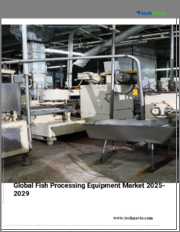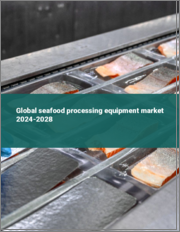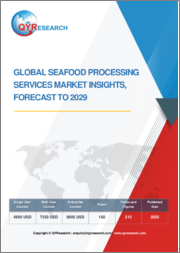
|
시장보고서
상품코드
1541247
수산 가공 장비 시장 보고서 : 수산물 유형, 장비 유형, 유통 채널, 지역별(2024-2032년)Seafood Processing Equipment Market Report by Seafood Type, Equipment Type, Distribution Channel, and Region 2024-2032 |
||||||
세계 수산 가공 장비 시장 규모는 2023년 20억 달러에 달했습니다. 향후 IMARC Group은 2032년까지 시장 규모가 30억 달러에 달해 2024-2032년 사이 4.3%의 연평균 성장률(CAGR)을 기록할 것으로 예측했습니다.
수산 가공 장비는 귀중한 가공 제품별을 회수하고 수산물 가공 시설의 효율성을 향상시키는 데 사용됩니다. 대형 고형물에서 처리수를 효율적으로 제거하고, 유지보수 및 운송 비용을 최소화하며, 처리 과정에서 발생하는 폐기물의 양을 줄이는 등 여러 가지 이점이 있습니다. 현재 수산물 유형에 따라 다양한 혁신적인 장비가 사용되고 있습니다. 예를 들어, 수명이 길고 조작이 간편하며 신뢰성이 높은 스테인리스 스틸 장비는 연어, 명태 등 다양한 어종 처리에 적용되고 있습니다.
수산 가공 장비 시장 동향
수산물 가공은 비교적 높은 농도의 생물학적 산소요구량(BOD)과 총부유물질(TSS)을 포함한 다량의 폐수를 발생시킵니다. 이는 제품 보관 및 조리 과정에서 발생하는 냄새를 억제하고 엄격한 식품 폐기물 처리 규정을 준수하기 위한 수산 가공 장비에 대한 수요를 촉진하는 주요 요인 중 하나입니다. 또한, 라이프스타일의 변화와 건강에 대한 관심이 높아지면서 전 세계적으로 수산물에 대한 수요가 증가하고 있으며, 이는 시장 성장에 기여하고 있습니다. 이와는 별도로, 반려동물의 인간화 추세, 대중의 지출 능력, 반려동물의 건강에 대한 반려동물 부모의 관심은 해산물을 포함한 영양가 높은 반려동물 사료를 적극적으로 채택하는 데 영향을 미치고 있습니다. 또한 수산물 가공 기술과 더 나은 포장 솔루션의 급속한 발전은 복잡한 제조 작업을 수행하고 원하는 식품 품질을 촉진하는 데 도움이되는 자동화 장비의 사용을 촉진하고 있습니다. 또한 일부 대기업은 역량을 강화한 혁신적인 디자인을 도입하기 위해 연구 개발(R & D) 활동에 투자하고 있으며, 이는 전 세계적으로 수산 가공 장비의 판매를 증가시킬 것으로 예상됩니다.
본 보고서에서 다루는 주요 질문들
- 세계 수산 가공 장비 시장은 지금까지 어떻게 성장해왔고 앞으로 어떻게 발전할 것인가?
- COVID-19가 세계 수산 가공 장비 시장에 미치는 영향은?
- 주요 지역 시장이란?
- 수산물 유형별 시장 현황은?
- 장비 유형별 시장 현황은?
- 유통 채널별 시장 현황은?
- 산업 가치사슬의 다양한 단계는 무엇인가?
- 업계의 주요 촉진요인과 과제는 무엇인가?
- 세계 수산 가공 장비 시장 구조와 주요 진출 기업은?
- 업계의 경쟁은 어느 정도인가?
목차
제1장 서문
제2장 조사 범위와 조사 방법
- 조사 목적
- 이해관계자
- 데이터 소스
- 1차 정보
- 2차 정보
- 시장 추정
- 상향식 접근
- 하향식 접근
- 조사 방법
제3장 주요 요약
제4장 소개
- 개요
- 주요 업계 동향
제5장 세계의 수산 가공 장비 시장
- 시장 개요
- 시장 실적
- COVID-19의 영향
- 시장 예측
제6장 시장 내역 : 수산물 유형별
- 어류
- 갑각류
- 연체동물
- 기타
제7장 시장 내역 : 장비 유형별
- 내장 제거
- 비늘 제거
- 껍질 벗기기
- 뼈 제거
- 살 바르기
- 기타
제8장 시장 내역 : 유통 채널별
- 슈퍼마켓과 하이퍼마켓
- 식품 전문점
- 편의점
- 기타
제9장 시장 내역 : 지역별
- 북미
- 미국
- 캐나다
- 아시아태평양
- 중국
- 일본
- 인도
- 한국
- 호주
- 인도네시아
- 기타
- 유럽
- 독일
- 프랑스
- 영국
- 이탈리아
- 스페인
- 러시아
- 기타
- 라틴아메리카
- 브라질
- 멕시코
- 기타
- 중동 및 아프리카
- 시장 동향
- 시장 내역 : 국가별
- 시장 예측
제10장 SWOT 분석
- 개요
- 강점
- 약점
- 기회
- 위협
제11장 밸류체인 분석
제12장 Porter's Five Forces 분석
- 개요
- 구매자의 교섭력
- 공급 기업의 교섭력
- 경쟁 정도
- 신규 참여업체의 위협
- 대체품의 위협
제13장 가격 분석
제14장 경쟁 상황
- 시장 구조
- 주요 기업
- 주요 기업 개요
- BAADER
- Bettcher Industries Inc
- CTB Inc.(Berkshire Hathaway Company)
- JBT Corporation
- KM Fish Machinery A/S
- Marel
- Pisces Fish Machinery Inc.
- SEAC AB
- Seafood Technology Limited
- Subzero(Grimsby) Limited
- Uni-Food Technic A/S
The global seafood processing equipment market size reached US$ 2.0 Billion in 2023. Looking forward, IMARC Group expects the market to reach US$ 3.0 Billion by 2032, exhibiting a growth rate (CAGR) of 4.3% during 2024-2032.
Seafood processing equipment is used to recover valuable processing byproducts and improve the efficiency of seafood processing facilities. It offers several advantages, such as removing process water from larger solids effectively, minimizing maintenance and transportation costs, and reducing waste volume in treatment processes. At present, it is available in a vast range of innovative equipment, which is utilized depending on the type of seafood. For instance, equipment made of stainless steel with long service life, simple operation, and high reliability find application in processing different fish species, such as salmon and pollock.
Seafood Processing Equipment Market Trends:
Seafood processing leads to a significant amount of wastewater with relatively high concentrations of biological oxygen demand (BOD) and total suspended solids (TSS). This represents one of the major factors driving the demand for seafood processing equipment to control odor from the storage and cooking of products and comply with stringent food waste disposable regulations. Moreover, changing lifestyles, along with the increasing health consciousness among individuals, are escalating the demand for seafood products across the globe, which, in turn, is contributing to the market growth. Apart from this, the growing trend of pet humanization, expenditure capacity of the masses, and concerns among pet parents about the well-being of their pets are influencing the adoption of nutritious pet food containing seafood positively. Furthermore, rapid advancements in seafood processing technologies and better packaging solutions are promoting the use of automated equipment, which helps to perform complex manufacturing operations and facilitate the desired food quality. In addition, several leading players are investing in research and development (R&D) activities to introduce innovative designs with enhanced capacities, which is projected to increase the sales of seafood processing equipment worldwide.
Key Market Segmentation:
IMARC Group provides an analysis of the key trends in each sub-segment of the global seafood processing equipment market report, along with forecasts at the global, regional and country level from 2024-2032. Our report has categorized the market based on seafood type, equipment type and distribution channel.
Breakup by Seafood Type:
Finfish
Crustaceans
Mollusks
Others
Breakup by Equipment Type:
Gutting
Scaling
Skinning
Deboning
Filleting
Others
Breakup by Distribution Channel:
Supermarkets and Hypermarkets
Food Specialty Stores
Convenient Stores
Others
Breakup by Region:
North America
United States
Canada
Asia-Pacific
China
Japan
India
South Korea
Australia
Indonesia
Others
Europe
Germany
France
United Kingdom
Italy
Spain
Russia
Others
Latin America
Brazil
Mexico
Others
Middle East and Africa
Competitive Landscape:
The competitive landscape of the industry has also been examined along with the profiles of the key players being BAADER, Bettcher Industries Inc, CTB Inc. (Berkshire Hathaway Company), JBT Corporation, KM Fish Machinery A/S, Marel, Pisces Fish Machinery Inc., SEAC AB, Seafood Technology Limited, Subzero (Grimsby) Limited and Uni-Food Technic A/S.
Key Questions Answered in This Report:
- How has the global seafood processing equipment market performed so far and how will it perform in the coming years?
- What has been the impact of COVID-19 on the global seafood processing equipment market?
- What are the key regional markets?
- What is the breakup of the market based on the seafood type?
- What is the breakup of the market based on the equipment type?
- What is the breakup of the market based on the distribution channel?
- What are the various stages in the value chain of the industry?
- What are the key driving factors and challenges in the industry?
- What is the structure of the global seafood processing equipment market and who are the key players?
- What is the degree of competition in the industry?
Table of Contents
1 Preface
2 Scope and Methodology
- 2.1 Objectives of the Study
- 2.2 Stakeholders
- 2.3 Data Sources
- 2.3.1 Primary Sources
- 2.3.2 Secondary Sources
- 2.4 Market Estimation
- 2.4.1 Bottom-Up Approach
- 2.4.2 Top-Down Approach
- 2.5 Forecasting Methodology
3 Executive Summary
4 Introduction
- 4.1 Overview
- 4.2 Key Industry Trends
5 Global Seafood Processing Equipment Market
- 5.1 Market Overview
- 5.2 Market Performance
- 5.3 Impact of COVID-19
- 5.4 Market Forecast
6 Market Breakup by Seafood Type
- 6.1 Finfish
- 6.1.1 Market Trends
- 6.1.2 Market Forecast
- 6.2 Crustaceans
- 6.2.1 Market Trends
- 6.2.2 Market Forecast
- 6.3 Mollusks
- 6.3.1 Market Trends
- 6.3.2 Market Forecast
- 6.4 Others
- 6.4.1 Market Trends
- 6.4.2 Market Forecast
7 Market Breakup by Equipment Type
- 7.1 Gutting
- 7.1.1 Market Trends
- 7.1.2 Market Forecast
- 7.2 Scaling
- 7.2.1 Market Trends
- 7.2.2 Market Forecast
- 7.3 Skinning
- 7.3.1 Market Trends
- 7.3.2 Market Forecast
- 7.4 Deboning
- 7.4.1 Market Trends
- 7.4.2 Market Forecast
- 7.5 Filleting
- 7.5.1 Market Trends
- 7.5.2 Market Forecast
- 7.6 Others
- 7.6.1 Market Trends
- 7.6.2 Market Forecast
8 Market Breakup by Distribution Channel
- 8.1 Supermarkets and Hypermarkets
- 8.1.1 Market Trends
- 8.1.2 Market Forecast
- 8.2 Food Specialty Stores
- 8.2.1 Market Trends
- 8.2.2 Market Forecast
- 8.3 Convenient Stores
- 8.3.1 Market Trends
- 8.3.2 Market Forecast
- 8.4 Others
- 8.4.1 Market Trends
- 8.4.2 Market Forecast
9 Market Breakup by Region
- 9.1 North America
- 9.1.1 United States
- 9.1.1.1 Market Trends
- 9.1.1.2 Market Forecast
- 9.1.2 Canada
- 9.1.2.1 Market Trends
- 9.1.2.2 Market Forecast
- 9.1.1 United States
- 9.2 Asia-Pacific
- 9.2.1 China
- 9.2.1.1 Market Trends
- 9.2.1.2 Market Forecast
- 9.2.2 Japan
- 9.2.2.1 Market Trends
- 9.2.2.2 Market Forecast
- 9.2.3 India
- 9.2.3.1 Market Trends
- 9.2.3.2 Market Forecast
- 9.2.4 South Korea
- 9.2.4.1 Market Trends
- 9.2.4.2 Market Forecast
- 9.2.5 Australia
- 9.2.5.1 Market Trends
- 9.2.5.2 Market Forecast
- 9.2.6 Indonesia
- 9.2.6.1 Market Trends
- 9.2.6.2 Market Forecast
- 9.2.7 Others
- 9.2.7.1 Market Trends
- 9.2.7.2 Market Forecast
- 9.2.1 China
- 9.3 Europe
- 9.3.1 Germany
- 9.3.1.1 Market Trends
- 9.3.1.2 Market Forecast
- 9.3.2 France
- 9.3.2.1 Market Trends
- 9.3.2.2 Market Forecast
- 9.3.3 United Kingdom
- 9.3.3.1 Market Trends
- 9.3.3.2 Market Forecast
- 9.3.4 Italy
- 9.3.4.1 Market Trends
- 9.3.4.2 Market Forecast
- 9.3.5 Spain
- 9.3.5.1 Market Trends
- 9.3.5.2 Market Forecast
- 9.3.6 Russia
- 9.3.6.1 Market Trends
- 9.3.6.2 Market Forecast
- 9.3.7 Others
- 9.3.7.1 Market Trends
- 9.3.7.2 Market Forecast
- 9.3.1 Germany
- 9.4 Latin America
- 9.4.1 Brazil
- 9.4.1.1 Market Trends
- 9.4.1.2 Market Forecast
- 9.4.2 Mexico
- 9.4.2.1 Market Trends
- 9.4.2.2 Market Forecast
- 9.4.3 Others
- 9.4.3.1 Market Trends
- 9.4.3.2 Market Forecast
- 9.4.1 Brazil
- 9.5 Middle East and Africa
- 9.5.1 Market Trends
- 9.5.2 Market Breakup by Country
- 9.5.3 Market Forecast
10 SWOT Analysis
- 10.1 Overview
- 10.2 Strengths
- 10.3 Weaknesses
- 10.4 Opportunities
- 10.5 Threats
11 Value Chain Analysis
12 Porters Five Forces Analysis
- 12.1 Overview
- 12.2 Bargaining Power of Buyers
- 12.3 Bargaining Power of Suppliers
- 12.4 Degree of Competition
- 12.5 Threat of New Entrants
- 12.6 Threat of Substitutes
13 Price Analysis
14 Competitive Landscape
- 14.1 Market Structure
- 14.2 Key Players
- 14.3 Profiles of Key Players
- 14.3.1 BAADER
- 14.3.1.1 Company Overview
- 14.3.1.2 Product Portfolio
- 14.3.2 Bettcher Industries Inc
- 14.3.2.1 Company Overview
- 14.3.2.2 Product Portfolio
- 14.3.3 CTB Inc. (Berkshire Hathaway Company)
- 14.3.3.1 Company Overview
- 14.3.3.2 Product Portfolio
- 14.3.4 JBT Corporation
- 14.3.4.1 Company Overview
- 14.3.4.2 Product Portfolio
- 14.3.4.3 Financials
- 14.3.5 KM Fish Machinery A/S
- 14.3.5.1 Company Overview
- 14.3.5.2 Product Portfolio
- 14.3.6 Marel
- 14.3.6.1 Company Overview
- 14.3.6.2 Product Portfolio
- 14.3.6.3 Financials
- 14.3.6.4 SWOT Analysis
- 14.3.7 Pisces Fish Machinery Inc.
- 14.3.7.1 Company Overview
- 14.3.7.2 Product Portfolio
- 14.3.8 SEAC AB
- 14.3.8.1 Company Overview
- 14.3.8.2 Product Portfolio
- 14.3.9 Seafood Technology Limited
- 14.3.9.1 Company Overview
- 14.3.9.2 Product Portfolio
- 14.3.10 Subzero (Grimsby) Limited
- 14.3.10.1 Company Overview
- 14.3.10.2 Product Portfolio
- 14.3.11 Uni-Food Technic A/S
- 14.3.11.1 Company Overview
- 14.3.11.2 Product Portfolio
- 14.3.1 BAADER



















